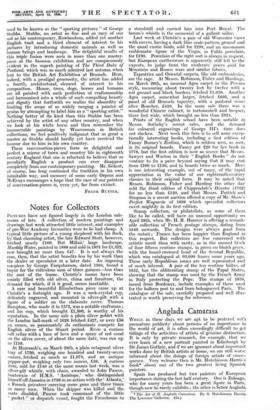Anglada Camarasa
WHILE in these days we are apt to be pestered with premature. publicity about persons of no importance in the world of art, it is often exceedingly difficult to get tidings of the activities of artists of genuine distinction. It is only by private research, for example, that we ever learn of a new portrait painted in Edinburgh by Sir James Guthrie, and if we are ignorant about important works done by British artists at home,- we are still worse informed about the, doings of foreign artists of conse- quence.. Very welcome then is Mr. Hutchinson Harris's book* about one of the two greatest living Spanish painters. Spain has produced but tw6 painters of European importance during the last half-century. One is Zuloaga, who - for many years has been a great -figure in Paris, though now he rarely exhibits ; the other is Senor Anglada • The An of H. Anglada Catnanaea. By S. Hutchinson Harris. The Leicester Galleries. 42s.) Carnarasa who, twenty years ago, was also a prominent figure in the Parisian art world, but since 1914 has retired from the hurly-burly of the exhibition arena and has lived quietly in the island of Mallorca, there continuing and perfecting his very individual and beautiful style of painting.
Born in 1874, Anglada is now fifty-six and it approaches tragedy that, so far as the newspaper public is concerned, he is less known to-day than he was when he was thirty- live. He came to Paris in 1897, exhibited in the New Salon of the following -year, and in 1902 was elected a member of the Societe Nationale des Beaux-Arts. For the next decade Anglada enjoyed an increasingly high reputation m Paris as a chef d'ecole ; he was one of the " personages " of Montparnasse and his school was well attended, among the best of his pupils then being Mr. Charles Ginner, now of the New English Art Club. Two or three times Anglada contributed to the London exhibitions of the International Society of Sculptors, Painters and Gravers, and some readers may yet remember his mag- nificently decorative Andalusian Peasant Group—with a gaily caparisoned white mule in the foreground— which for design, beauty of colour and quality of paint was the most prominent work in one of these exhibitions.
With the exception of these rare appearances at the International, Anglada has shown practically' nothing of his work in London. Several second and third-rate Spanish painters have had one-man shows and have been extensively advertised, but we have not yet had an Anglada exhibition, in London.
Excellent and well chosen as are the plates in Mr. Harris's book, they cannot fully convey the power and charm of Anglada's work to those who have never seen his original paintings, because while his work has many other merits, it remains true that the distinctive feature of Anglada's art, is his very wonderful sense of colour. And Mr. Harris' is not able to give us a colour-plate. In this respect Anglada is incontestably the superior of Zuloaga, whose constant use of blacks no doubt suits his rather macabre subject-matter, but taken en masse is depressing when contrasted with the soft enchantment of Anglada's lighter, yet exquisitely mellow, colour schemes.
What this book does show, however, is Anglada's magnificent draughtsmanship. His firm grasp of form, and his unerring sense of tactile values are displayed in the finely-modelled back of his Torso (Plate XXXIV), and the two Studies of Heads (Plate )(XXIII). Some of Anglada's superb chalk and charcoal figure studies would also have been welcome as illustrations.
Mr. Harris divides Anglada's paintings into four categories. He begins with a survey of those Andalusian and Valencian subjects with which the artist first won his reputation in Paris. Next he devotes a chapter to Anglada's portraits—which are always well-characterized as well as decorative in design. Then he gives a chapter to Anglada's many paintings of gipsies, and he concludes with a chapter to which he gives the title of " Nature." In this Mr. Harris deals with the most recent work the painter has done in Mallorca ; landscapes, marines, and a new kind of " submarine genre " which Anglada has invented for himself. With all respect to the interesting exploration which Mr. Julius Olsson, ILA., has made in this field, it must be admitted that no artist has yet obtained results so rich from " under-the-sea " subjects as Anglada. Each Secret Fishy Hope or Fear (Plate XLVII) and The Depths of the Sea give some idea of the peculiar blend of romance, naturalism and decoration which Anglada has 'woven into glorious unity in these unique paintings. But even these admir- able reproductions' cannot convey the Magical fascination of the lovely colour in the originals. It must be con- fessed, I suppose, that Anglada is a romanticist, and romantic art is very unfashionable with young people to-day. If there is sentiment in his work, however, there is nothing even approaching sentimentality. The sentiment is provoked, not by associations nor by. any "literary subject," but by the distinguished design and supreme loveliness of colour which hall-mark the paintings of that really great artist, H. Anglada Carnarasa.
F. R.



























































 Previous page
Previous page